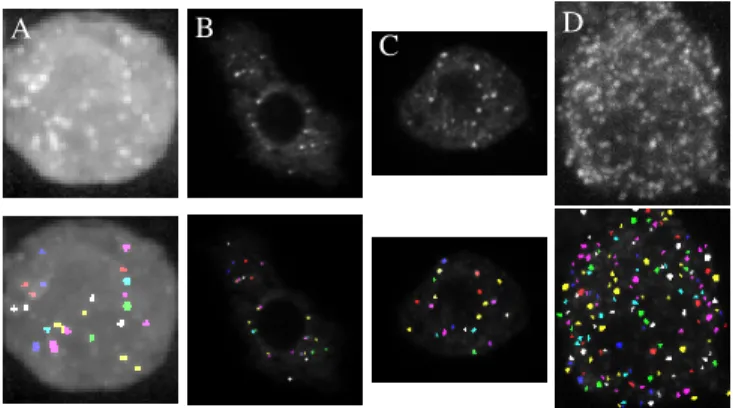HAL Id: hal-01867805
https://hal.inria.fr/hal-01867805
Submitted on 4 Sep 2018
HAL is a multi-disciplinary open access
archive for the deposit and dissemination of
sci-entific research documents, whether they are
pub-lished or not. The documents may come from
teaching and research institutions in France or
abroad, or from public or private research centers.
L’archive ouverte pluridisciplinaire HAL, est
destinée au dépôt et à la diffusion de documents
scientifiques de niveau recherche, publiés ou non,
émanant des établissements d’enseignement et de
recherche français ou étrangers, des laboratoires
publics ou privés.
SPADE: A Small Particle Detection Method Using A
Dictionary Of Shapes Within The Marked Point Process
Framework
Nicolas Cedilnik, Eric Debreuve, Fabienne de Graeve, Florence Besse, Xavier
Descombes
To cite this version:
Nicolas Cedilnik, Eric Debreuve, Fabienne de Graeve, Florence Besse, Xavier Descombes. SPADE: A
Small Particle Detection Method Using A Dictionary Of Shapes Within The Marked Point Process
Framework. IEEE International Symposium on Biomedical Imaging (ISBI), Apr 2018, Washington,
DC, United States. �hal-01867805�
SPADE: A SMALL PARTICLE DETECTION METHOD USING A DICTIONARY OF SHAPES
WITHIN THE MARKED POINT PROCESS FRAMEWORK
Nicolas Cedilnik
?†, Eric Debreuve
?¶, Fabienne De Graeve
?§, Florence Besse
?§, Xavier Descombes
?†?
Universit´e Cˆote d’Azur, Team Morpheme
†
Inria
¶Centre National de la Recherche Scientifique
§Valrose Biology Institute
ABSTRACT
We introduce SPADE (small particle detection), a novel method to detect and characterize objects only a few pixel large on microscopy images, based on the use of a dictionary of shapes (Figure 1).
It involves the minimization of an energy function em-bedding a prior and a data fidelity term to match shapes of the dictionary with patterns in images. The data fidelity term is a comparison between the pixels’ intensities within a potential match and the surrounding pixels’ intensities. It can be de-fined in different ways, from simple averages differences to formulas incorporating variance of the intensities. The prior forbids any overlap between the matched shapes. The sensi-tivity of the detector can be tuned using a minimal threshold on the data fidelity term.
Using synthetic images of increasing blur, i.e., detection difficulty, we showed that, on certain images, SPADE can out-perform widely used methods in this classical task of biolog-ical image processing (Figure 2). We also show that the data fidelity term must be adapted to the nature of the images in order to get the best results.
We then apply SPADE, in a real-case scenario, on con-focal fluorescence microscopy images of D. melanogaster cultured cells where cytoplasmic ribonucleoproteic granules have to be detected and characterized (Figure 3). We demon-strate that our method can be calibrated for high-throughput screening imaging study, generating a F1 detection score of
0.76 after cross-validation using a trained biologist expertise as ground truth (data not shown).
An open-source python implementation of SPADE has been released on the Python Package Index1. Different
dic-tonaries of shapes and data fidelity terms could be used for different applications.
Index Terms— Image processing, Object detection, High-content (high-throughput) screening, Single cell & molecule detection
1https://pypi.python.org/pypi/
small-particle-detection/
Fig. 1.SPADE default dictionary of shapes and their contours
1.0 1.5 2.0 2.5 3.0 3.5 4.5 4.5 5.0 Standard deviation of the Gaussian kernel used for blurring 0 0.2 0.4 0.6 0.8 1 S co re F 1 1 2 3 4 5 Standard deviation of Gaussian kernel used for blurring 0.0 0.2 0.4 0.6 0.8 1.0 F1 score (Detection) 1.0 1.5 2.0 2.5 3.0 3.5 4.0 4.5 5.0 Standard deviation of gaussian kernel using for blurring 0 0.2 0.4 0.6 0.8 1 S co re F 1 Intensity thresholding Icy's wavelet-based spot detector SPADE - mean intensity difference SPADE - median intensity difference SPADE - "max min" difference SPADE - Welch t test SPADE - Bharracharyya coefficient SPADE - Pseudo-Bhattacharrya coefficient
1 2 3 4 5
Standard deviation of Gaussian kernel used for blurring 0.0 0.2 0.4 0.6 0.8 1.0 F1 score (Jaccard)
Fig. 2. Evaluation of SPADE (different data fidelity terms, green and blue) against a wavelet-based detector ( ) and simple inten-sity thresholding ( ) on synthetic images
A B
C D
Fig. 3. Examples of real images (top) and the corresponding SPADE detections (bottom) Particles are fusion proteins (Green flu-orescent protein-Imp), except (D): in situ hybridization with quasar 570-marked oligonucleotidic probes.
